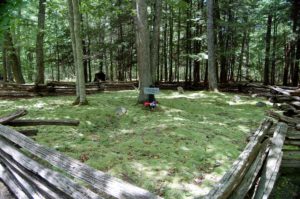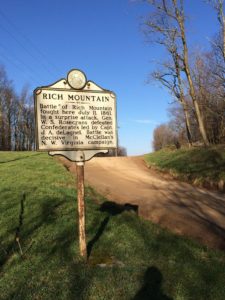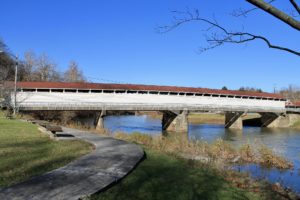
If you’ve ever wondered why there is both a Virginia and West Virginia state, you’ll be interested to discover that the latter actually achieved statehood after seceding from the former during the American Civil War. It is the only such state to be formed by splitting off from a Confederate entity. It was certainly a brave stance at the time, and one that would undoubtedly help turn the area into a hotbed of activity during the war. Below are but a few of the more well-known sites that you can visit today to honor the brave souls who took the ultimate stance against slavery.

Carnifex Ferry Battlefield State Park
Now a popular destination for Civil War reenactments, this state park on the edge of Gauley River Canyon was once site of one of the most influential battles of the war. After an attempted siege of the area near Carnifex Ferry, Union troops gathered up reinforcements and reclaimed the land on September 10th, 1861, forcing the Confederate army to retreat and leading to their eventual withdrawal from what was at that time western Virginia state.

In fact, it is this battle – named after the family who originally settled the area – that helped lead to the founding of West Virginia. Today, the Carnifex Ferry Battlefield is one of the oldest state parks in the country and the 156-acre expanse is part of the Civil War Discovery Trail, which spans 16 states and connects over 300 historical sites. There is a trio of trails located at this park, ranging from the 0.3-mile Old Ferry Road to the 2-mile Patterson Trail, with the Pierson Hollow Trail falling in between at just over half a mile.

Droop Mountain Battlefield State Park
This park’s significance lies in the fact that it is the site of the last major battle of the Civil War within the state. The Battle of Droop Mountain, which occurred on November 6th, 1863, saw Brigadier General W.W. Averell and Colonel Thomas M. Harris lead the Union troops to victory in a conflict that would, for all intents and purposes, chase the Confederacy from West Virginia.

Thanks to the Civilian Conservation Corps, the land was dedicated as the state’s first state park on July 4th, 1928, due in large part to the efforts of John D. Sutton while he served as a delegate on West Virginia’s lower house legislature. As it stands today, the park features several picnic areas as well as eight separate hiking trails, the longest of which are 0.75 miles and vary in level of difficulty to traverse. Additionally, the site also includes an observation tower that allows for panoramic views of the Greenbrier River valley. If you’re visiting in October of an even-numbered year, there is also the opportunity to witness a Civil War reenactment.

Harpers Ferry National Historical Park
During the Civil War, Harpers Ferry changed hands at least eight times as the Union troops and the Confederacy fought for control of this pivotal boundary point between the two opposing forces. The reason it was such a highly sought after fortification was due to its being a center for manufacturing as well as its strategic location in the Shenandoah Valley, along the Baltimore and Ohio Railroad.

The back and forth battles ravaged the town, as each army would set fire to strongholds as they abandoned them in the hopes of keeping weapons and manufacturing equipment out of enemy hands. Originally declared a national monument, this land now helps comprise the nearly 4,000-acre park that rests between the Potomac and Shenandoah river valleys. Roughly 70% of the area consists of forest and is home to a variety of plant and animal species, including 30 species of mammal and more than 170 varieties of birds. The numerous trails allow for access to such popular points of interests as Jefferson Rock and the Maryland Heights Overlook – from which visitors can view the ruins of Union forts and infantry encampments. A guided ranger tour is also available throughout the year, save for summer.

Rich Mountain Battlefield State Park
The Battle of Rich Mountain was one of the more brief conflicts of the war, as it was resolved after just one day – July 11th, 1861, to be exact. The conflict between a trio of separately led Union regiments and John Pegram’s Confederate forces over control of the Staunton-Parkersburg Turnpike would be over in a matter of two hours, ending with the southern troops divided and on the run. The Union victory at Rich Mountain helped vault George B. McClellan, a major general who commanded one of the three Federal forces during the onslaught, to leader of the Army of the Potomac. Situated five miles west of Beverly, the Rich Mountain Battlefield Civil War Site & Visitor Center consists of 57 acres of land preserved and managed by the Civil War Trust. It includes hiking trails, picnic areas, and signage that provides insight into the events that occurred on this land over 150 years ago. Also located on the site is the Beverly Heritage Center, which houses research facilities as well as exhibits such as “The 1st Campaign of the Civil War”.

Philippi Covered Bridge
Though not a battle-“field”, per se, this 312-foot bridge spanning the Tygart Valley River would come to mark the site of the first organized land battle of the American Civil War. The plan was for two separate regiments, each numbering in the neighborhood of 1,500 Union troops, to converge on an under-armed force of 800 Confederate soldiers camped out in Philippi. However, after the assault was prematurely triggered the Union army was unable to cut off the escape route of the southern troops. During the largely non-violent skirmish, Union troops utilized the bridge for lodging, while their opposition had been holed up in tents waiting out a storm. The bridge – which was rebuilt in 1989 after being destroyed by fire – now stands 285-feet long, making it not only one of the oldest structures of its kind in West Virginia but also one of the longest. Since 1972, the bridge has been included on the National Register of Historic Places and remains in use by the federal highway system to this day.




